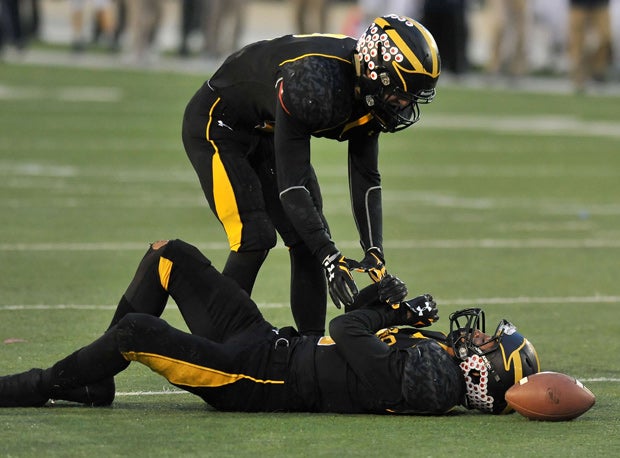Video: Top 10 Plays Of The Year 2015-16
See some amazing feats from last seasonBy CHRIS FOREYour scrimmage is coming up fast. Take advantage of it!
Your kids can't wait to hit someone with a different-colored jersey, and no doubt you can't wait to see how the troops will perform. Make sure to improve as a program, not just on the field, but on the sidelines too. Use the scrimmage to help launch your program in to a great 2016 season!
Three keys for maximizing game day organization during your scrimmage
1. Have an organized play cardMany times during the offseason, coordinators like to rethink their game day play card. Maybe they see a different play card at a clinic, or they run across one online or in a book they read. The scrimmage is your last shot to make sure that what you are going to use on Friday nights for calling plays is set and ready to go.
Can you read it under the lights? Is it safe from sweat and water, or the elements you might play in? Does it flow well as you read it?
Don't wait for your first game to use that play card.
2. Have an organized depth chartSuccessful programs are very organized, like a well-oiled machine. Part of keeping that machine running is being prepared when a "part" breaks.
What happens when during the second play of the game, your running back gets injured? Or on the first punt, your long snapper breaks his wrist? Are you prepared?
I'll never forget my first game as a head coach, when we had our first injury. Our backup was also injured. As soon as our kid wasn't getting up, I yelled for the backup, totally forgetting that he was not even dressed out.
That's what happens sometimes in the heat of the battle as a head coach or coordinator. We were down to our third-string kid, who was also a backup at another position. Guess what? He was already in the game as a backup, because that starter was cramping as well. We had to burn a timeout because I wasn't prepared with a proper depth chart.
That's the first and last time I made that mistake!
And don't forget your special teams depth chart either. There are 66 starting spots on your special teams, that's a lot of moving parts. My guess is that many of your players play many spots. You'd better be prepared to replace Johnny on kickoff, punt and PAT if he breaks his leg.
Don't wait for your first game to practice your depth chart!

Is your coaching staff prepared for what happens when you have an injured player? Use your scrimmage to practice the substitutions.
Photo by Louis Lopez
True, you have probably already had your staff meeting, and you've probably already reviewed your sideline communication protocol. However, there is nothing like the heat of the battle to test your communication protocol.
Who is wearing headsets? Who is responsible for charging them up? For bringing them? For setting them up?
Beyond the physical communication system, the scrimmage is a great time to put in to practice how and when the assistant coaches speak to the coordinators, the coordinators to the head coach, the coordinators to the players, etc.
Most programs have some sort of turnover in the offseason. This might be your very first game with a new offensive coordinator. Does he meet with the entire offense after every series? Does he get input from assistants before doing that? Where do they meet? How will you treat two-way players as far as communication goes?
If you're a head coach, make sure to discuss all of these communication issues with your staff during the week of your scrimmage, and then put that philosophy in to practice on scrimmage night. Take notes during the scrimmage of things to correct for your first game. Do this on an index card that easily fits in your pocket, or on your game day call sheet.
Chris Fore is a veteran head football coach and athletic director from Southern California. He consults coaches and programs nationwide through his business Eight Laces Consulting.